![]() I sometimes forget that I only became as good as I am at videogames because of the formative butt-kickings of my youth. Nowadays, I can blaze through most standard-length platformers in a single sitting—my blind playthrough of Mega Pony is proof enough of that—but every once in a while, I’ll be reminded of what it took to get this far. Such was the case with Castlevania: Rondo of Blood, which started as a lazy Monday evening conquest and ended a full two weeks later.
I sometimes forget that I only became as good as I am at videogames because of the formative butt-kickings of my youth. Nowadays, I can blaze through most standard-length platformers in a single sitting—my blind playthrough of Mega Pony is proof enough of that—but every once in a while, I’ll be reminded of what it took to get this far. Such was the case with Castlevania: Rondo of Blood, which started as a lazy Monday evening conquest and ended a full two weeks later.
On the surface, Rondo (I’ll call it Rondo, rather than RoB, to avoid confusion with Dracula’s other curse) is your typical classic-style (read: nothing like Metroid) Castlevania game. As Richter Belmont, descendant of whichever Belmont it was who passed down his hereditary robot legs, you’ll take on a resurrected Dracula and his army of monsters—gargoyles, bats, ghosts, golems, harpies, a minotaur, a sea serpent, even Death himself—who are terrorizing the populace out of contractual obligation. There is a castle. There might even be a vania somewhere. It’s hard to tell when the game is inconsiderate enough to speak a language not everyone on the planet can understand. The game’s not really named Castlevania: Rondo of Blood; that’s just what we call it in parts of the world where we can’t pronounce Akumajou Dracula X: Chi no Rondo (literally, “The Mojo of Dracula 10: Rondo of Chi”).
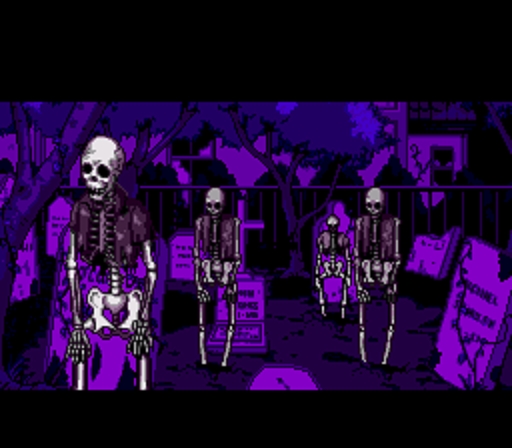 Evidently, this town buries its dead without pants.
Evidently, this town buries its dead without pants.
The story is told primarily through Japanese voice-acted cutscenes, with a little bit of German thrown in (no doubt to cater to the “I want to feel doubly alienated by only speaking English and Spanish” crowd). Even without having a clue what anyone is saying, it’s obvious that Richter’s quest also includes rescuing a little girl, a nurse, a nun, and his girlfriend picking up chicks, as far as I can tell. There’s also a kindly ferryman who speaks in Japanese text, so I guess I have no basis for determining he’s kindly. Fortunately, the words “GAME OVER” are written in English, so the part of the story where you’re an utter failure will be clear enough.
Rondo is tough as nails in a coffin, but it is surprisingly fair: our less-than-nimble hero suffers from what I like to call “Richter mortis,” but quick reflexes aren’t the focus of the gameplay. The game is all about pattern recognition and good timing, with a dash of creative problem-solving—it’s a puzzle game that plays out like a platformer. Can’t move quickly enough to dodge projectiles? Try knocking them out of the air with your whip. Keep getting hit by an enemy with long reach? Try smacking them once and retreating instead of trying to take them down before they strike. There are no cheap deaths or impossible challenges, just a lack of practice and experimentation. Well, aside from in Stage 5′, which looks like one of the developers let their kid play with the level editor without telling them there were more challenges available than “long, boring hallway with the same enemy over and over” and “randomly generated enemies knock you into a hole every time you jump”.
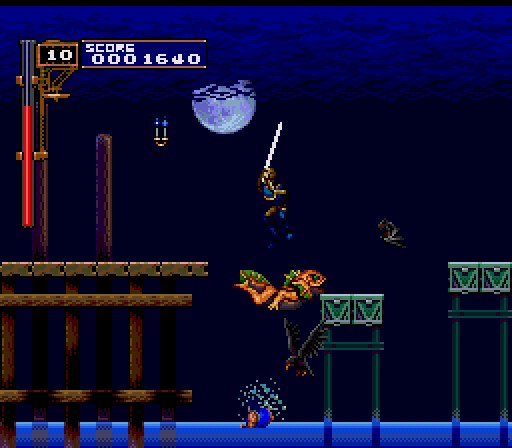 More like Rondo of Blub.
More like Rondo of Blub.
Without realizing I had a wide array of moves and attacks at my fingertips, I started off playing the game as a moron. Mash buttons until it dies! Don’t avoid attacks until you see them coming! It shouldn’t have come as a shock that I had multiple playing sessions where I didn’t clear a single stage—I was so hung up on what Richter couldn’t do that I had a hard time working a strategy around what he could do. As soon as I started looking things up and understood the full scope of his strengths and limitations, the challenge became figuring out how best to approach each situation, instead of figuring out why Richter was so dumb.
So you’ve got your standard-issue 300-something-year-old whip, which your ancestors used to obviously not kill Dracula well enough. With a little bit of finesse when you strike, you can double-tap the control pad to extend the reach of your Drac-thwapper. Whipping candles and suspicious-looking walls will reveal everything from money (which can be used on the menu screen to purchase hint videos) to life-replenishing food (eating meat that’s sitting in the wall of a dank castle is obviously good for your health) to bright red hearts and the versatile sub-weapons they power. It’s the usual assortment of Castlevania armaments—a boomerang cross, a high-arcing axe, flammable gag-gift holy water that is a riot at baptisms, and so on—but unlike previous entries in the series, you’ve got a few moments’ grace period to recover your old sub-weapon after picking up that stupid stopwatch by accident a new one.
 Richter is about to be fired, while the wyvern will soon be getting the axe. Castlevania: Portrait of Unemployment.
Richter is about to be fired, while the wyvern will soon be getting the axe. Castlevania: Portrait of Unemployment.
Sub-weapons consume a modest number of hearts with every use, but you can expend a…um…what’s the opposite of modest? A promiscuous number of hearts to execute an Item Crush attack. Richter unleashes a deluge of daggers, a barrier of Bibles, or a flagellation of flames, depending on what he’s got equipped, and these powerful attacks are great fun to watch. Rounding out his move set are a backflip, a duck (the crouching kind of duck; attacking with an animal would be silly), the option to hop up stairs or intentionally Gerald Ford his way off them, a moonwalk to keep him in attack position as he retreats from enemies like a smooth criminal, and a mild midair course correction that might make him the first Belmont in history to jump like a normal videogame character. Richter is an exemplar of archaic gameplay refined to its limit—anything more, and you lose that classic Castlevania feel; anything less, and you remember why you hate playing classic Castlevania.
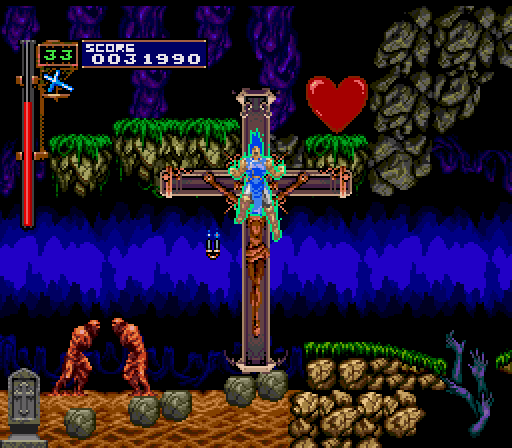 Cross my heart and hope to…make everything else die?
Cross my heart and hope to…make everything else die?
Despite my aversion to patience and strategy as requirements for basic survival in a platformer, I soon embraced Richter’s style of gameplay, in large part because the level design makes it work brilliantly. Rondo features some of the most thoughtfully and deliberately crafted stages I’ve ever seen in a Castlevania game—and yes, I’ve played enough of them for that statement to mean anything.
There’s at least one good opportunity to use all of Richter’s moves and powers, including the stupid stopwatch. There’s a superb learning curve that starts you off fighting cannon-fodder recruits in otherwise child-safe locations, graduates you to basic platforming with slightly stronger and trickier enemies, and culminates in challenges such as an entire stage that’s nothing but boss battles, a race across a crumbling bridge with flying enemies constantly at your back, and a really long staircase that’s completely uneventful but looks terribly exhausting to climb. Checkpoints are well-placed, as are the various items you can get from whipping walls and candles—search hard enough, and you’ll almost always find enough health or the right kind of firepower to give you a fair shot at getting to the next checkpoint alive. The types and combinations of enemies and geographical features are diverse and appropriately challenging, too. Stage 5′ notwithstanding, the developers knew how to make kicking my butt an art.
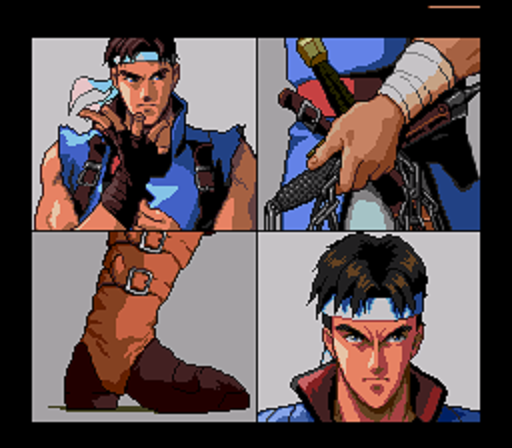 Richter prepares for a whuppin’. Probably his own.
Richter prepares for a whuppin’. Probably his own.
The gameplay alone would be enough to win me over, but Rondo also delivers a triple whammy of visual spectacle, audio bliss, and well-executed nostalgia. Throwbacks abound: familiar foes, locations, and musical themes return from previous games in the series, often with a neat twist to help keep them fresher than the rotting corpses they could so easily be. I appreciate the level of detail and quality in the graphics, the clarity of the voices, and the richness and texture of the soundtrack. Admittedly, most of the cutscenes look like they were drawn in MS Paint (albeit by someone with skill), but all the character sprites and backgrounds and animations are quite pretty, or at least as pretty as torture chambers and ghastly hands reaching out of the ground can be. The music is decidedly more ’90s pop/rock than creepy Gothic, but the energy of it makes the game fun, so my descent into insanity after a few weeks of being unable to get these tunes out of my head has been most enjoyable.
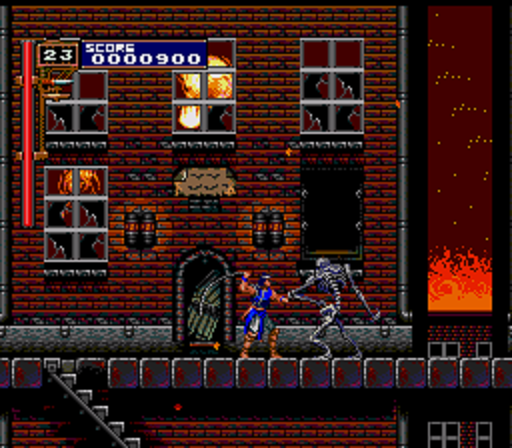 Welcome back to that town whose name you can’t remember from the game you want to forget. (Unless you like Castlevania II, in which case…yay Aljiba! … Which looks more like Jova.)
Welcome back to that town whose name you can’t remember from the game you want to forget. (Unless you like Castlevania II, in which case…yay Aljiba! … Which looks more like Jova.)
Further enhancing the experience is a satisfying amount of replay value, which I would’ve entirely missed if the menu screen hadn’t shown my completion status as far less than 100% after beating the game, left a blank spot for something on my options list, and had a picture of the one girl I rescued standing on a platform big enough for two or three other people. Rondo has secret rooms and multiple paths scattered throughout almost every stage, and some of the alternate routes lead to alternate bosses and alternate stages (hence Stage 5 and Stage 5′, with the apostrophe that looks like a typo). Fortunately, there’s a stage select option that allows completionists to easily go back and poke around for everything they missed; unfortunately, the only way to return to the menu screen to check your progress is to play through to the end or get a Game Over. Incidentally, you have infinite continues, but the game keeps track of how many times you use one; along with an end-of-stage point bonus if you take no damage, the perfectionist has just as many ways to measure their success as the completionist.
The women you can rescue are locked away in some of the aforementioned secret rooms, but the littlest of them all—Maria Renard—gives even the non-completionist a legitimate reason to save her (and no, it’s not some made-up reason like “altruism”). Not only does she give you a short cutscene like the others, but she joins you as a playable character. That’s right: a 12-year-old girl slaying zombies and succubi by…throwing cats at them. Her frilly pink dress hides the bloodstains well.
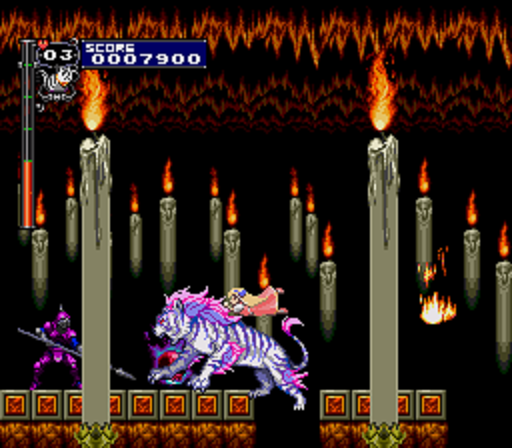 Looks like you brought a spear to a catfight, my friend.
Looks like you brought a spear to a catfight, my friend.
Maria utterly demolishes the seriousness of the game, pecking her enemies to death with boomerang attack doves, recovering heath with ice cream and birthday cake instead of wall-turkey, and utilizing dragons, turtles, and the joy of music as sub-weapons. Her unique arsenal is just as good as Richter’s, if not better, and a secret move that unleashes her “darker side” can trim boss battles from minutes down to seconds. Due to the apparent squishiness of pre-adolescent vampire huntresses, she takes more damage than Richter does, but her agility more than makes up for this deficiency: faster movement, a double-jump, and a Mega Man-worthy slide give her significant advantages over Richter and her enemies alike. In the event these strengths still aren’t enough for you to prevail against the Lord of Shadow and his infernal minions, Maria departs this world with “GAME OVER” displayed in cutesy bubble letters and surrounded by happy flowers. It’s worth playing through once as Richter for the challenge and the atmosphere, but Maria is so incongruously ridiculous and powerful that I almost don’t want to play the game any other way.
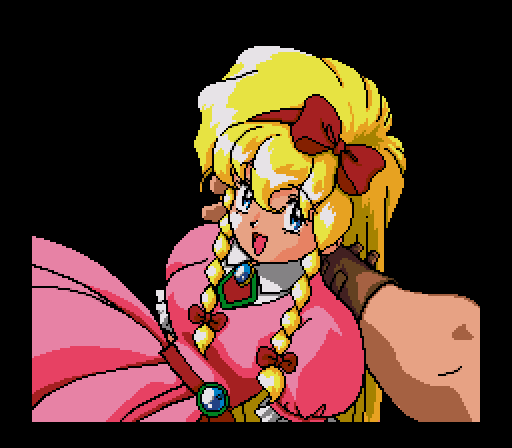 Congratulations! It’s a vampire slayer!
Congratulations! It’s a vampire slayer!
If there’s anything holding the game back, it’s mostly a matter of personal preference. Well, aside from a few minor ways the otherwise flawlessly reliable controls could be streamlined, a handful of spots where a challenge continues to drag on after you’ve necessarily mastered it to get that far, and a few areas that are suspicious to the point where the game almost feels incomplete without…whatever was clearly supposed to be there. Everything else is a matter of personal preference, except for the one about exiting stages that’s also legitimate criticism but fits better in the next paragraph.
As alluded to before, I’m not a patient gamer when it comes to platformers; Maria can rush into most situations and improvise her way out, but Richter often needs to have a well-choreographed routine before standing any chance of survival, and that routine tends to involve some amount of waiting for things to happen. I’m generally not so keen on the undead, the occult, or anything traditionally horror-related in my entertainment—I realize that’s like saying Wizards & Warriors isn’t as good a game as it could’ve been because it has wizards and warriors, but there you have it. As a completionist, it’s a little annoying to have a stage select feature and a built-in way to track my progress to 100% but not the option to easily exit stages where I’ve already found all the secrets. As a gaijin (literally, “some word non-Japanese people use to describe themselves”), it’s hard for me to appreciate the story because of the language barrier, and that makes the datedness of the visuals in the cutscenes that much harder to ignore. Replace me with a Japanese-speaking diehard Castlevania fan, and suddenly this is one of the best games of its kind.
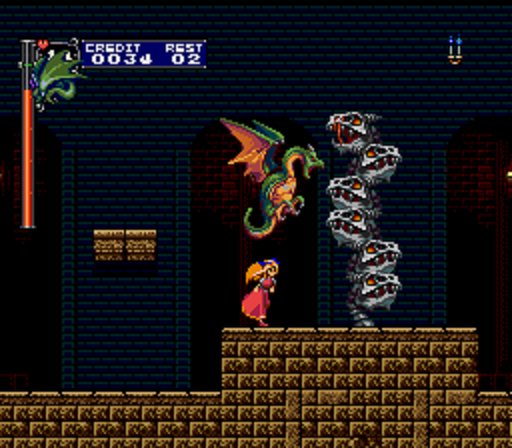 Toppling this entire tower with a dragon is a highlight, to be sure.
Toppling this entire tower with a dragon is a highlight, to be sure.
And, really, it is. Smart level design, fair challenges, an excellent learning curve, awesomely catchy music, generally good graphics with great animations, responsive controls, two unique playable characters with fun and varied abilities, a significant but manageable amount of replay value, just the right amount of nostalgia, a built-in optional hint system; heck, there’s even a partridge in a pear tree, or at least the opportunity to send an attack partridge into a pair of trees. Practically everything about the original Japanese PC Engine version is preserved in the Wii Virtual Console version; about the only notable differences are that the original German voiceover for the intro has been replaced with a more ominous German voiceover, and the werewolf boss’s post-transformation nudity has been censored by way of replacing his manhood with a big circle of nothing. I think the German dude got the better end of the deal.
Maybe you’re into Castlevania; maybe you’ve tried other games in the series (perhaps Dracula X, Rondo‘s oft-derided SNES port that might as well be a different game entirely?) and hated them. I’ll give you the same conclusion either way: Castlevania: Rondo of Blood is a triumph both as a platformer and a sequel, and it comes highly recommended to anyone—fan of the series or not—who could use a good butt-kicking.
